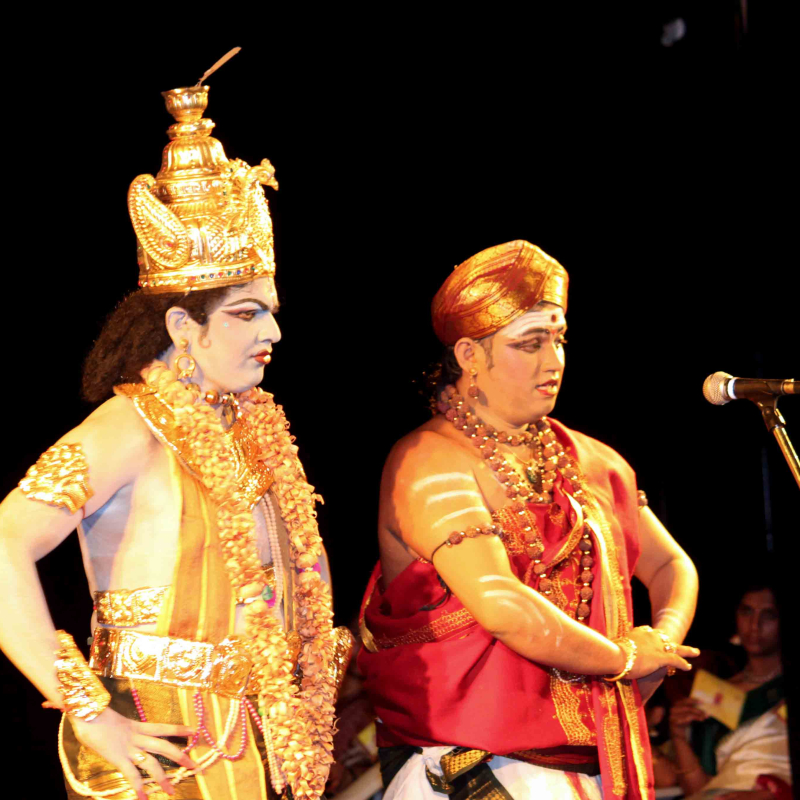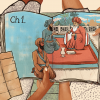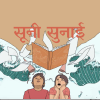The origin of the dance traditions of Andhra Pradesh can be traced through various sources, such as the sculptures and inscriptions in ancient temples, Buddhist ruins, the migrations of the Arava Dravida community and various works of literature. Before the fourteenth century, when Yakshagana and Bhagavata Meḷa traditions took root in Andhra, Vaishnavism was prevalent in the region, and consequently, the Krishna cult was popular. The devadasis (devotees of god) and the rajanartakis (court dancers) in the Srikakulam region danced to hymns in praise of Lord Krishna.
Though there is evidence of the existence of Kuchipudi as early as the tenth century, it is believed that it was Siddhendra Yogi who, in the seventeenth century, undertook the responsibility of propagating Kuchipudi and giving it a new dimension.[1] Siddhendra Yogi hailed from Kuchipudi, went to Udupi and became a follower of Madhvacarya. He later migrated to the Krishna district in Andhra Pradesh. He was a pioneer who refined and redefined Kuchipudi. The Hemadeita (where only male Brahmins could perform, even in female roles) dance-drama tradition was followed.
There are several stories regarding the birth and life of Siddhendra Yogi. He was an ardent devotee of Lord Krishna. His studies under the influence of the Udupi Mutt propelled him towards a spiritual path. Upon his return to Srikakulam, he sought the blessings of his elders and decided to meet his wife who lived across the river Krishna. On his way across the river, a violent storm broke out, and he was almost drowned midstream. He prayed to Lord Krishna with all his might. This incident had shaken him up, and he decided to take up sanyasa and renounce conjugal life and all worldly pleasures. His teacher (guru) at Udupi Mutt preached that Radha (the consort of Krishna) was considered prakriti (nature), whereas Krishna was purusha (man). Prakriti owed her very existence to her lord. This made him conclude that sensuous love was not necessarily a sin, but it ought to be sublimated and enjoyed following dharma (righteousness). This was called the Bhama cult, later known as the Madhura Bhakti. Siddhendra thought that every devotee was a consort of Lord Krishna, and Lord Krishna was a Lokabharta (husband).
Imagining himself to be Satyabhama, who could not stand the separation from her lord, be it even for a moment, he composed many songs and titles, and the collection is known as Bhama Kalapam. The songs were of sensuous love. The viraha (separation) he experienced in his own life poured forth in the form of beautiful lyrics—the composition Bhama Kalapam is a reflection of the Jivatma-Paramatma concept, where the poet compares himself to the character of the nayika (heroine or the female counterpart), Satyabhama, who longs for union with the only supreme male or the paramatma, Lord Krishna.
Kalapam
In her book, The World of Koochipudi Dance, Dr Swapnasundari states that the word kalapam has many meanings. In Sanskrit, it refers to ‘that which holds single parts together, bundle, totality, collection of several separate things, a series of four stanzas in grammatical connection.’[2] In Telugu, too, the meaning is similar—‘an ornament, an assemblage playing a character.’ The Kalapam is a collection of ideas contained within a seemingly simple story. Although the Kalapam is not known as an uparupaka (dance drama), the salient features found in Margi literature (associated with the classical style of dance described in the Natyashastra) resemble the format of the Kalapam. A form of the uparupaka (minor types of Sanskrit plays that emerged from Rupaka [one of the ten major plays defined by Bharata in Natyashastra]), ‘Srigaditham’ bears the closest resemblance to the Kalapam structure.
The structure of the Srigaditham has been described in detail within Bhoja’s Sringara Prakasam (King Bhoja of Malwa, eleventh century) and Saradatanaya’s Bhava Prakasam. It is also briefly mentioned in Jayapasenani’s Nritta Ratnavali. Upon parallel comparison of Saradatanaya’s Bhava Prakasam and Bhooja’s Sringara Prakasam, the nayaka (hero) must be prasiddha (famous) and possess high quality of character. He must be so powerful that he can slay demons. He is assumed to be the incarnation of Lord Vishnu. The nayika is a kulangana (hailing from a reputed family/clan), and suffers from the separation of her beloved, and undergoes several emotional states. The emotion in the composition is vipralabha sringara (love in separation) and vṛitti (the style of dramatic production) is bharativritti (bharati–verbal).
Typically, a single protagonist presents a range of ideas and carries the story forward. The focus is on the main character rather than on the supporting role. The prominent member of the supporting cast is known as sutradhari (conductor/narrator). The dancers who perform should be well versed in singing, dancing and rendering prose dialogues as well. The storyline is conveyed through the use of daruvus, padyams and slokas (literary structures of Yakshagana with specific meters) along with most other features derived from Yakshaganam.[3]
The most famous kalapams in Kuchipudi are the Bhama Kalapam, Bhagavatula Ramayya’s Golla Kalapam, Sri Vedantam Parvatisam’s Durjati Kalapam, and, in more recent times, Dr Vedantam Ramalinga Sastry’s Uma Kalapam. A kalapam brings out the effect of the dramatic sequence by the subjective exposition of the characters themselves, accompanied by a systematic dance and tune suggestive of the situation.
Siddhendra Yogi and Kalapams
Siddhendra trained under Sri Narayana Tirtha, the author of Sri Krishna Lila Tarangiṇi. The story goes that when Lord Krishna appeared and told Siddhendra that he would be liberated from the mundane world, he weaved the story of Parijatapaharanam into a fine sringarakavya (erotic/love poem); he said that his master Sri Narayaṇa Tirtha would attain liberation in his next birth. This episode made Siddhendra write Parijatapaharanam, which later on came to be known as Bhama Kalapam. He gathered a few Brahmin boys, taught them and asked them to perform it as a dance drama and as an offering to Lord Krishna. They, in turn, assured him that they would retain and preserve the culture. The descendants of those Brahmin families continued this tradition of the Kuchipudi dance drama. The Brahmin artistes came to be known as Bhagavatulu, and the dance-drama from the Bhagavatamela nataka was referred to as the Kuchipudi dance drama after the name of the village.[4]
Siddhendra Yogi wrote many Kalapams. He primarily developed a unique and particular style based on the Natyasashtra and Nandikesvara’s Bharataraṇava. He initiated young Brahmin boys to Bhama Kalapam. The actual training of the actors was developed to turn them into Bhagavatula, or performers of the Bhagavata Mela Natakams (theatres), which are prevalent until this day—making glorious history in Kuchipudi.
Bhama Kalapam
The main story of Bhama Kalapam is based on Satyabhama’s estrangement from Krishna. Satyabhama is annoyed that Krishna has presented the celestial flower, Parijata, to Rukmini, his previous wife. Satyabhama considers herself more beautiful and well-bred than the other wives of Krishna, and therefore feels that she deserves the gift. This forms the background of the Bhama Kalapam, although the complete episode is indirectly referred to in its performance.
The story starts with Satyabhama proclaiming her special qualities. She requests a friend to bring Krishna to her palace. The friend seeks an explanation from Satyabhama for the reason behind her separation from her lord. In response to this, Satyabhama refers to her love quarrel[5] with Krishna. She yearns for reconciliation and sends the emissary with a letter to him. Initially unresponsive, Krishna eventually returns to Satyabhama. The sutradhari enacts the dual role of Madhavi (Satyabhama’s confidante) and Madhava (friend of Krishna) without any change of costume but with imaginative use of accessories. By playing the dual role of both Satyabhama and Krishna’s friend, the sutradhari maintains the connectivity between the jivatma (which Satyabhama represents) and paramatma (embodied by Krishna). Symbolically, the confluence of jivatma with paramatma is highlighted.[6]
Although Bhama Kalapam was written in the form of a Yakshagana—it comprises daruvus, padyams, gadyam, kandarthams and dvipadas (all literary structures). It was not a dance drama in the true sense but had a complicated, traditional story and scenes. It can be referred to as prabhandakavya (a literary genre of medieval Indian Sanskrit literature) describing the different moods and feelings of the heroine Satyabhama. In her quest for Lord Krishna and her pain of separation, she experiences several nayikavasthas (physical expressions of the different aspects of the heroine's feelings and emotions) such as svadhinapatika (one who is swollen with pride of her beloved’s love and devotion), virahootkantitha (one who is distressed and desires reunion with her lover), khandita (one who sends away the deceitful lover in anger, the lover who had disappointed and saddened her), proshitabhartrika (one who is missing her beloved as he is far away on a long journey) and abhisarika (one who courageously goes out for the meeting with her lover). The dasakamavasthas as described in the Naṭyasashtra are articulated at various segments within the kalapam. The salient features or sequences of Bhama Kalapam include:
|
Prasthavana |
An introductory sequence which states the substance of the play; generally done through pravesa daruvu. |
|
Bhama samvadam |
Satyabhama’s conversations with the other characters—mostly Madhavi. |
|
Avadhi |
The cause of conflict/misfortune; the mirror is the cause for the quarrel between Satyabhama and Krishna. |
|
Viraham |
Suffering the pangs of separation from the beloved. |
|
Svapnavastha |
A dream-like situation often recalling the pleasant state with the beloved. |
|
Sapatni vivadam |
The quarrel of two wives; Satyabhama’s tussle with Rukmini to gain Krishna’s attention (this was important in the older versions). |
|
Dutika samvadam |
The conversation of Satyabhama and her emissary; the protracted debate between the two about giving the bejewelled nose pin as an incentive for running an errand (forms an important sequence). |
|
Candropalambhana |
Blaming the moon for heightening physical passion, and thereby the suffering of separated lovers. |
|
Manmathoopalambhana |
Blaming Manmatha, the God of love, for causing heightened desire and thereby increased suffering; The impact of Manmatha’s flower-darts is portrayed in the impassioned sequence danced by Satyabhama. |
|
Vayopalambhana |
Blaming the breeze for fanning the flames of passion, thereby causing suffering to separated lovers. |
|
Murcavastha |
The state of swooning or fainting out of frustrated love—this sequence leads to the eventual reunion of Krishna and Satyabhama. |
Golla Kalapam
Kuchipudi dance is renowned for the dramatic practice of expanding the process of a single role within a play. Such plays with their well-defined presentational aspects are believed to be derived from a format known as vesha katha (person adorning a character). Another kalapam which stayed with Kuchipudi dance-drama is Golla Kalapam written by Bhagavatula Ramayya, who belonged to the early eighteenth century.[7]
The operatic dance drama rests on a weighty libretto with a vedantic theme containing several layers of meaning. At one level, it is simply a light-hearted exchange between a Golla Bhama and a Brahmin. At another level, it conveys a message of the universality of the human spirit and underscores the futility of caste-based distinction. The dance opera serves as a metaphor for the process of self-realisation. It abounds in the philosophy of life from birth to death. For the first time in dance-drama, the author has introduced both the spiritual and biological aspects depicting Vedic sacrifices, yagna and the process of human birth.
The story has two characters—the milkmaid and the Brahmin. The Brahmin and Golla Bhama set out on a journey engaging in a friendly repartee. The Brahmin refuses the buttermilk offered saying that a member of a higher caste would not accept anything touched by a member of a lower caste. The milkmaid is equally well versed with the sastric and puranic lores and traces her lineage to Lord Krishna, who was also a golla (a cowherd). She refutes all arguments put forward by the Brahmin who is superior by birth. The milkmaid finally emphasises the oneness of creation and the supremacy of the lord—the unique expression of his self in all his creations.[8] The salient features of Golla Kalapam as listed by Dr Swapnasundari in the book The World of Koochipudi Dance are:
|
Panca mahayagnam |
Five great devotional rituals of Brahmins |
|
Panca kosham |
The five sheaths of the soul |
|
Pindotpatti |
Formation of the foetus |
|
Bhupathanam |
Infusion of life force in-vitro |
|
Bahyam, kaumaryam, yauvanam, vardhakyam |
The four stages of all life on earth—childhood, adolescence, youth and old age |
|
Yagnyam |
The most important fire ritual amongst the Hindus |
|
Purvapaksham |
The first objection to an assertion in any discussion—the prima facie view or argument in any question; one side of a question in logic |
|
Siddhantam |
Established truth, principles and doctrines of Vedanta |
Similarities and contrasts between Bhama Kalapam and Golla Kalapam
The ideas emerging as vesya kathas appear to have been more sophisticated representations in kalapams. Kalapams of Kuchipudi developed all three aspects of dance—nṛitta (dance steps performed rhythmically), abhinaya (emoting the song) and natya (dramatic representation) equally.
Both Bhama Kalapam and Golla Kalapam are priceless assets to the literature of dance. They are perfect examples to show that our scriptures are poems with philosophical content and that our literature is a spiritual treatise with romantic content. They are complementary to each other to reveal the truth of the art as envisaged in ancient days, i.e. ways to reach God through art.[9]
In both the Kalapams, the format was set in such a way that the lead dancer had to have good stamina, memory, knowledge of philosophy and scriptures, and a good command over the language to render vacikam (dialogues). Both the Kalapams is a remarkable audio-visual treat to the audience and are an aesthetic experience.
The tabular representation of both the kalapams have been summarised with a few connotations below:
|
Bhama Kalapam |
Golla Kalapam |
|
More relevant to Bhakti cult |
More relevant to Vedic cult |
|
The heroine is Satyabhama |
The heroine is a milkmaid, Golla Bhama |
|
The heroine enters with grandeur in the Pravesa Daruvu |
The heroine enters the stage selling milk and butter in the Pravesa Daruvu |
|
The conversation is between the confidante Madhavi and Satyabhama |
The argument is between Golla Bhama and the Brahmin |
|
The union of the jivatma with the paramatma is the highlight |
The philosophical discussion of life and death is the highlight |
|
A 'localised' story with a ‘contextualised theme’ of the lord and his consort |
Speaks of the origins of the universe, narrating the story of the samudra manthanam, (churning of the ocean of milk), and the story of saving it from the raksasas (demons) by Lord Krishna |
|
Dissimilarities between what one believes, and the real truth as it is, is what Bhama Kalapam dramatises |
A short prelude showing dissimilarities in human temperament is what Golla Kalapam aims at |
|
Sheathed in a romantic veneer. |
Woven in philosophical attire |
|
The values represent individual to the universal |
The values represent universal to the individual
|
Notes
[1] Rama, ‘Siddhendra Yogi’.
[2] Sundari, ‘Kalaapam’, 69.
[3] Sundari, ‘Kalaapam’.
[4] Devi, Kuchipudi Kalapas.
[5] Sundari, ‘Kalaapam’, 78.
[6] Kothari, Kuchipudi.
[7] Sundari, ‘Kalaapam’.
[8] Kothari, Kuchipudi.
[9] Sarma, Kuchipudi: Gurus.
Bibliography
Devi, P. Rama. Kuchipudi Kalapas: An Odyssey Rediscovered. Secunderabad: Patinjarayil Publications, 2004.
Kothari, Sunil. Kuchipudi: Indian Classical Dance Art. New Delhi: Abhinav Publications, 2001.
Rao, Uma Rama. ‘Siddhendra Yogi.’ In Kuchipudi Bharatam or Kuchipudi Dance: A South Indian Classical Dance Tradition. New Delhi: Sri Satguru Publications, 1992.
Sarma, M.N. Kuchipudi: Gurus, Performers And Performance Traditions. Hyderabad: Creative Links Publications, 2016.
Sundari, D. Swapna. ‘Kalaapam’. In The World of Koochipudi Dance. Haryana: Shubhi Publications, 2005.













